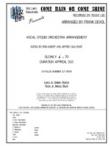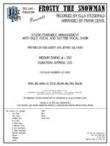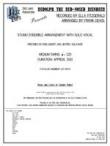ST. LOUIS BLUES
Recorded by Ella Fitzgerald
Arranged by Frank DeVol, Prepared by Rob DuBoff and Jeffrey Sultanof

Cat #: JLP-9630
$65.00This item usually ships within 1 business day.
Questions?
Please call +1-518-587-1102 or email us.
Edition: Jazz Big Band Arrangement with Vocal
Description: Swing - Difficult
Publisher: Jazz Lines Publications
It's not hard to imagine that arranger Frank DeVol issued a challenge to himself while writing this arrangement to find a way to showcase every aspect of Ella Fitzgerald's wide ranging musicianship into a single chart. Whether he did this or not, it's safe to say that DeVol's arrangement of 'St. Louis Blues' did in fact accomplish this goal.
Norman Granz was so impressed with the albums that Frank Sinatra was recording for Capitol Records (featuring arrangements by Nelson Riddle and Billy May) that he hired Frank DeVol as Ella's arranger and set about producing a session that would be an attempt at duplicating this sound and success. DeVol was an obvious choice due to his significant commercial experience in a variety of contexts. Recorded over multiple sessions from 1957 to 1959, the concept featured Ella singing well-known standards by varying composers and released as a contrast to her song books albums being simultaneously recorded.
The arrangement begins with a brass blast above an ascending unison saxophone line that should experience a natural series of dynamic swells as the line goes higher. Fitzgerald enters with the chestnut of a melody at measure 5. The band performs a call-and-response with itself, with the saxophones playing backgrounds behind the more notey sections of the melody while the brass fill in during the melody's held notes.
The arrangement kicks into a slightly-faster-than double time for the rumba interlude at measure 29 with some appropriately exotic saxophone and trombone backgrounds. The arrangement takes a turn for the brisk with a sudden upshot in tempo at measure 38. An ensemble blast and a brief piano fill sets up the final section of the melody at this new quick tempo. Fitzgerald takes on a more playful approach to the melody at this time, and your vocalist is advised to do the same (Ella's vocal melody has been transcribed here as a model). The ensemble continues to provide a call-and-response accompaniment to the vocals before Fitzgerald engages in one of her incomparable scat solos beginning at measure 90. Although the backgrounds should remain underneath the vocalist throughout, there should be a gradually increasing sense of urgency during this section as the arrangement barrels forward toward its conclusion.
Said conclusion begins when Fitzgerald returns to traditional lyrics beginning at measure 114. At this point, the ensemble should be at full roar, especially for the climactic final few bars at measure 124. The ensemble plays a brief line that descends in register but not volume or power before coming back with the final (surprisingly happy sounding) chord.
This arrangement is for female vocalist with jazz big band. It is not a transcription - it has been prepared from the original set of parts used during the recording session. The vocal key is Bb throughout.
Vocal
2 Alto Saxophones
2 Tenor Saxophones
Baritone Saxophone
4 Trumpets
3 Trombones
Guitar
Piano
Bass
Drums
Trumpet 1: E6
Trombone 1: Bb4










